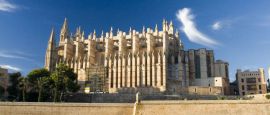Mallorca Weather, climate and geography
Weather & climate
The island enjoys a temperate, Mediterranean climate. The height of summer can get very hot – in excess of 40°C - but the cooling influence of the sea means it's seldom excessively uncomfortable or humid. Summer is the busiest time of the year and prices are at their highest in July and August. During the rest of the year Mallorca has an ideal climate, with comfortable temperatures in the mid- to high-twenties during the spring and autumn months. Combined with fewer visitors and lower hotel prices, this makes for the best time to visit and is also the best time for outdoor activities such as cycling and hiking holidays. The climate during the winter is generally mild and dry with occasional showers, making Mallorca an ideal winter getaway. The shoulder seasons (April-May and September-October) are generally the perfect time to get the best of the weather and to avoid the crowds.
The summer months are extremely hot so lightweight clothing is needed. Long-sleeved cotton tops are recommended as they protect from the fierce sun, especially for sightseeing or activities. Autumn and spring attire should be medium-weight clothing, mainly layers, with some light rainwear, while the winters can be cold so a good jacket, scarf and gloves might be necessary.
Geography
Located in the middle of the Mediterranean Sea, approximately 210km (130 miles) south of Barcelona and 300km (185 miles) north of the African continent (Algeria), Mallorca has an idyllic geographical setting. Measuring 3,640 sq km (1,405 sq miles), it is the largest of the four Balearic Islands (Ibiza and Formentera to the west and Menorca to the east) and has a hugely varied landscape.
Its main geographical feature is the Sierra de Tramuntana mountain range, which extends from the southwest to northeast of the island over 70km (44 miles), the highest peak being Puig Major at 1,445m (4,741ft). The coast is mainly rocky, pocketed with small coves, sandy beaches and caves. Three large bays provide shelter from the open seas – Palma Bay, Alcúdia Bay and Pollensa Bay. The interior of the island is covered with lush pine forest, olive and almond trees, and in the central plains agricultural terrain and vineyards.
Protected nature reserves are important for wildlife, the most significant of these being the Cabrera Island Marine Reserve and the S’Albufera Nature Reserve near Alcúdia. There are hundreds of bird species that call Mallorca home, although wild mammals are today rare, the main exception being the wild goat that can be seen in the mountainous regions.
Do you have any Feedback about this page?
© 2025 Columbus Travel Media Ltd. All rights reserved. No part of this site may be reproduced without our written permission, click here for information on Columbus Content Solutions.




 You know where
You know where